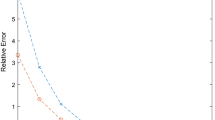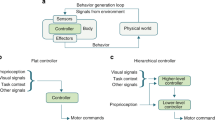Abstract.
This paper discusses similarities between models of adaptive motor control suggested by recent experiments with human and animal subjects, and the structure of a new control law derived mathematically from nonlinear stability theory. In both models, the control actions required to track a specified trajectory are adaptively assembled from a large collection of simple computational elements. By adaptively recombining these elements, the controllers develop complex internal models which are used to compensate for the effects of externally imposed forces or changes in the physical properties of the system. On a motor learning task involving planar, multi-joint arm motions, the simulated performance of the mathematical model is shown to be qualitatively similar to observed human performance, suggesting that the model captures some of the interesting features of the dynamics of low-level motor adaptation.
Similar content being viewed by others
Author information
Authors and Affiliations
Additional information
Received: 20 September 1994 / Accepted in revised form: 18 November 1998
Rights and permissions
About this article
Cite this article
Sanner, R., Kosha, M. A mathematical model of the adaptive control of human arm motions. Biol Cybern 80, 369–382 (1999). https://doi.org/10.1007/s004220050532
Issue Date:
DOI: https://doi.org/10.1007/s004220050532




